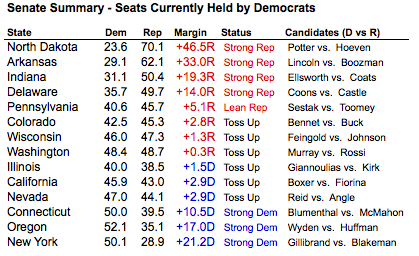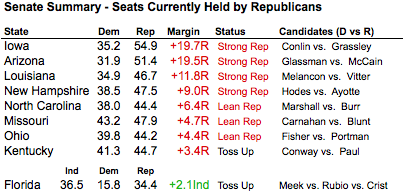Is the Democratic Senate majority in peril? A lot of political observers have been asking that question in recent weeks, and as of today, polls show Republican candidates running clearly ahead in four to five Senate seats currently held by Democrats, with another six Dem seats falling squarely into our "toss-up" category.
Control of the Senate will largely depend on the outcome of those toss-up races. The Republicans have a path to majority control, but it will require sweeping nearly all of the close contests.
Today we begin what will soon be a regular daily feature on HuffPost's Pollster, in which we review the day's polls and monitor their impact on our polling averages and trends. We will also be watching House and gubernatorial elections, but for today I want to begin with an overview of the races for the Senate.
Let's first take a step back and consider the classic "horse race" poll question that we plot on our charts and use to assess where each race stands. The question usually asks voters to make a choice as if "the election were held today" and prompts with both the names and party affiliations of each candidate.
When voters are familiar with the competing candidates -- as they usually are a few days before the election -- the standard horse-race question has proven to be an accurate and reliable measure of their preferences. However, when voters know some candidates but not all, the predictive accuracy of the vote question starts to erode, and the horse-race results can become misleading. That scenario still exists in many Senate races, so there is still potential for shifting between now and November.
Currently, the Democratic Senate Caucus has 59 members: 57 elected as Democrats plus independents Bernie Sanders (Vt.) and Joe Lieberman (Conn.). In order to be assured a majority, the Republicans would need to gain 10 seats, since Vice President Biden would vote with the Democrats to break a 50-to-50 tie.
So based on the available public polling, how many seats would the Republicans gain "if the election were held today?" Let's use the Pollster.com trend estimates (based on all available polling data) to consider voter preferences in the competitive races in Senate seats currently held by Democrats.

Republican candidates currently hold huge leads in four states currently represented by the Democrats -- North Dakota, Arkansas, Indiana and Delaware -- and in a fifth, Pennsylvania, Pat Toomey leads by just slightly more than 5 percentage points (45.7% to 40.6%). Using the system we applied in 2008, we classify all five of these states as strongly or leaning Republican.
What should concern Democrats even more, however, is that polling yields closer "toss-up" margins in another six states held by Democratic Senators -- Colorado, Wisconsin, Washington, Illinois, California and Nevada. That said, Republicans would need to win five of the six and prevail in two similarly close contests in states currently represented by Republicans (Florida and Kentucky) to gain control of the Senate.

The "toss-up" label above may overstate the degree of uncertainty "if the election were held today" in some of the contests. In Nevada, for example, four of the five polls conducted in the last month show Harry Reid with small, nominal leads of 1 to 4 percentage points. Recent polling in California shows a similar pattern favoring Democrat Barbara Boxer.
We will soon unveil a more granular system of classifying each race. But for now, our older classification scheme helps put these results into the context of recent history. The lesson is that a lead of two or three percentage points in late August can be fleeting.
In late August 2006, it certainly looked like Democrats faced an "uphill fight" to win control of the Senate. At the time, Republican candidates led by low single-digit margins on most polls conducted in Missouri and Virginia (the latter conducted just after George Allen's infamous "Macaca" moment), yet Democrats Claire McCaskill and Jim Webb went on to win their respective races. Democratic Senate candidates also gained significantly on their Republican opponents during the fall campaign in New Jersey, Ohio, Rhode Island, and Washington.
Four years ago, our similarly constructed assessments of Senate-race polling as of early September added up to 50 seats held by Republicans or at least leaning that way, 46 seats held or leaning to the Democrats, and four toss-ups. Yet the Democrats ultimately gained enough support to over the course of the fall campaign to win the 51 seats necessary to gain control of the Senate.
Compare the 50 to 46 Republican advantage at this point in 2006 to the current standings: Right now, we show 48 states currently represented by Republicans or at least leaning that way in this year's elections (including Lieberman and Sanders), 45 states held by or at least leaning Republican and seven states in the toss-up column.
None of this argues that Republicans will see gains over the next two months comparable to what Democrats experienced in the fall of 2006, only that the possibility exists. For now a Republican takeover does not look probable, but we certainly cannot rule it out.
